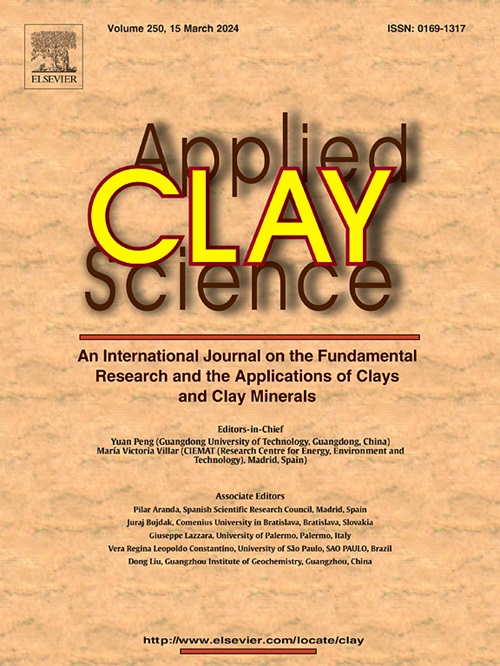Bentonite and organobentonite nanocomposite for removing chromium species from aqueous solutions
IF 5.3
2区 地球科学
Q2 CHEMISTRY, PHYSICAL
引用次数: 0
Abstract
Batch adsorption studies were used to assess the effectiveness of bentonite and a synthetized Bentonite HDTMA+/clay nanocomposite in removing chromium species from aqueous solution. Characterization of adsorbents using XRD, FTIR, SEM/EDX, TGA/DTA, and BET method reveals that larger amount of HDTMA+ is located in the interlayer and outer surface of Bt, resulting in the efficiency modified Bt for higher removal of chromium species. The parameters involved in the adsorption process, including contact time, adsorption temperature, adsorbent mass, initial chromium concentration, and solution pH, were optimized. It was found that the HDTMA+/Bt composite had a higher adsorption capacity (250 mg/g) than Bt (2.73 mg/g) under optimal testing conditions: equilibrium period of 120 min for both adsorbents, pH = 2, m = 0.2 g of adsorbents, and chromium ion concentration of 2 10−4 M. The adsorption kinetics were found to be nonlinear pseudo-second-order, with intraparticle diffusion not being the main controlled adsorption step, and the thermodynamic parameters indicated the endothermicity of the spontaneous adsorption process. The isotherm data could be fitted by the Langmuir and Freundlich adsorption models. This could be owing to the surface heterogeneity of the adsorbents, resulting in a hybrid adsorption process at multi adsorption sites. The FTIR spectra revealed Cr![]() O bond vibration bands caused by electrostatic interactions, Van der Waals forces, and hydrogen bonding between adsorbents and chromium species. Regeneration tests demonstrate that theses adsorbents could be reused even after five cycles, which makes them much more cost-efficient and environmentally friendly, especially in applications like water treatment.
O bond vibration bands caused by electrostatic interactions, Van der Waals forces, and hydrogen bonding between adsorbents and chromium species. Regeneration tests demonstrate that theses adsorbents could be reused even after five cycles, which makes them much more cost-efficient and environmentally friendly, especially in applications like water treatment.
膨润土和有机膨润土纳米复合材料去除水溶液中的铬
通过批量吸附研究,考察了膨润土和合成膨润土HDTMA+/粘土纳米复合材料去除水溶液中铬的效果。利用XRD、FTIR、SEM/EDX、TGA/DTA和BET等方法对吸附材料进行表征,发现大量的HDTMA+位于Bt的层间和外表面,使得改性后的Bt对铬的去除率更高。对接触时间、吸附温度、吸附剂质量、初始铬浓度、溶液pH等吸附过程的参数进行了优化。结果发现,在最佳测试条件下,HDTMA+/Bt复合材料的吸附量(250 mg/g)高于Bt (2.73 mg/g);两种吸附剂的平衡时间均为120 min, pH = 2,吸附剂m = 0.2 g,铬离子浓度为2 10 ~ 4 m,吸附动力学为非线性拟二阶,颗粒内扩散不是控制吸附的主要步骤,热力学参数表明吸附过程是自发吸热的。等温线数据可以用Langmuir和Freundlich吸附模型拟合。这可能是由于吸附剂的表面不均匀性,导致在多个吸附位点的混合吸附过程。FTIR光谱显示了吸附剂与铬之间的静电相互作用、范德华力和氢键作用引起的CrO键振动带。再生试验表明,这些吸附剂即使在五个循环后也可以重复使用,这使得它们更具成本效益和环境友好性,特别是在水处理等应用中。
本文章由计算机程序翻译,如有差异,请以英文原文为准。
求助全文
约1分钟内获得全文
求助全文
来源期刊

Applied Clay Science
地学-矿物学
CiteScore
10.30
自引率
10.70%
发文量
289
审稿时长
39 days
期刊介绍:
Applied Clay Science aims to be an international journal attracting high quality scientific papers on clays and clay minerals, including research papers, reviews, and technical notes. The journal covers typical subjects of Fundamental and Applied Clay Science such as:
• Synthesis and purification
• Structural, crystallographic and mineralogical properties of clays and clay minerals
• Thermal properties of clays and clay minerals
• Physico-chemical properties including i) surface and interface properties; ii) thermodynamic properties; iii) mechanical properties
• Interaction with water, with polar and apolar molecules
• Colloidal properties and rheology
• Adsorption, Intercalation, Ionic exchange
• Genesis and deposits of clay minerals
• Geology and geochemistry of clays
• Modification of clays and clay minerals properties by thermal and physical treatments
• Modification by chemical treatments with organic and inorganic molecules(organoclays, pillared clays)
• Modification by biological microorganisms. etc...
 求助内容:
求助内容: 应助结果提醒方式:
应助结果提醒方式:


